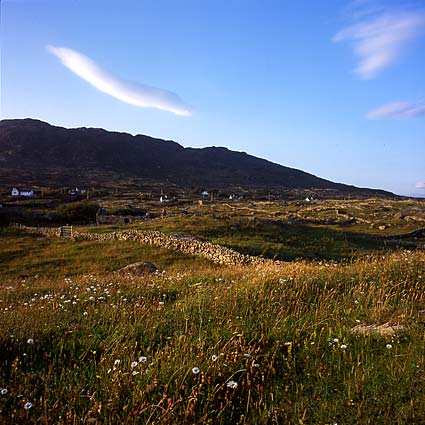
The first time I visited the Scottish Highlands they made a lasting impression. Such wide horizons, so much peace. Magnificent light and endless coasts and islands. An untouched part of Europe.
I have been there many times now. I have came to love the country more and more, its beauty is unsurpassed - but now I know it isn't untouched at all. Without men the country would have been totally different.

Many natural and historical developments added to the Scottish and Irish landscape. In this article the most important are mentioned. The scope is limited to the Scottish highlands & islands and the Irish west coast. These make for a geological, ecological and historical continuity.
This is by no means a travel guide nor is it a 'not to be missed' list. No general history of both countries: I only mention what is to be seen in the landscape.
This isn't a survey of plants and animals either. Of course all creatures are closely linked to the landscape they live in, but they are not discussed here - whole books could be written on the landscape alone! I have to limit myself here.
This article discusses what applies to the entire area or the most important parts. Things that only occur in a specific area are discussed in the portfolios.
[ To enlarge a photo illustrating the text, one can click on the photographs. The enlargements are shown in separate windows. These can be clicked away for further reading of the text. ]
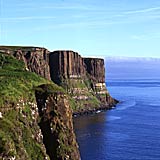 One can encounter the geological past almost everywhere on the British Isles. Especially at the coast and in the
mountains the different stone layers and rocks are easily visible. Spectacular rocks were formed by volcanic activity and elsewhere by erosion.
One can encounter the geological past almost everywhere on the British Isles. Especially at the coast and in the
mountains the different stone layers and rocks are easily visible. Spectacular rocks were formed by volcanic activity and elsewhere by erosion.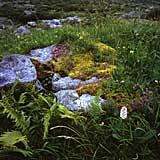 Most of the Scottish Highlands and Ireland's westcoast have a rather poor soil. The rocks are often very hard and the soil turns acid very easily by lack of lime. There are exceptions though.
Most of the Scottish Highlands and Ireland's westcoast have a rather poor soil. The rocks are often very hard and the soil turns acid very easily by lack of lime. There are exceptions though.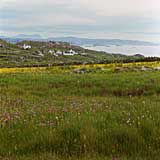 Under the influence of water, wind and ice the soft lime rock is split throughout and underground rivers and caves are formed. This soil created the perfect habitat for a very special flora: lots of flowers grow here that are only found elsewhere in Arctic, Alpine and Mediterranean regions!
Under the influence of water, wind and ice the soft lime rock is split throughout and underground rivers and caves are formed. This soil created the perfect habitat for a very special flora: lots of flowers grow here that are only found elsewhere in Arctic, Alpine and Mediterranean regions!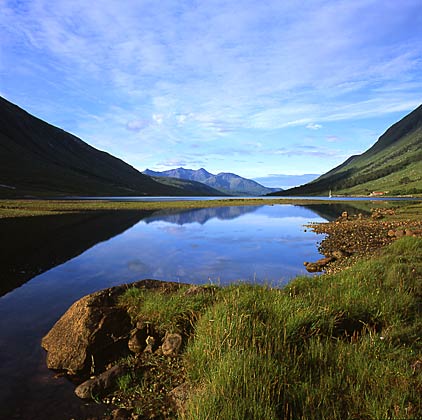
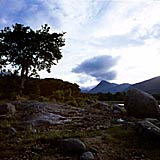 More recently but still more than ten thousand years ago, the landscape was further formed by enormous amounts of ice, covering large parts of the earth. Gigantic glaciers like the ones that can be found in Greenland created - especially in the Highlands - the typical V- and U-shaped glens. At the end of these glens near the sea the moraines can be found: boulders rounded by the erosive powers of the glaciers.
More recently but still more than ten thousand years ago, the landscape was further formed by enormous amounts of ice, covering large parts of the earth. Gigantic glaciers like the ones that can be found in Greenland created - especially in the Highlands - the typical V- and U-shaped glens. At the end of these glens near the sea the moraines can be found: boulders rounded by the erosive powers of the glaciers.
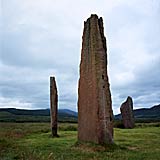
Probably around 6000 BC man settled in Scotland and Ireland. Their wooden houses, fields, boats and tools can only be found through excavations. Their graves, stone circles and standing stones however are to be seen everywhere.
Elsewhere in Western Europe most of these Neolithic monuments were 'cleared' in recent times, but particularly in Ireland were left in peace as the haunts of elves and ghosts.
In the same period that prehistoric people built their megalithic monuments they cleared large areas of the landscape - which at time was almost entirely forested. They made
pastures for their cattle and cultivated cereals and vegetables.
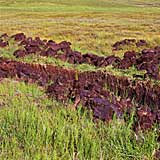 Because of these clearings and a change of the climate, which grew wetter and colder, large areas of bog - originally
occurring only in the very north of Scotland, known as Flow Country - came into being. In this acid
environment trees could hardly survive. The dead plants did not decay entirely. This resulted in thick layers of peat, at some places up to seven metres.
Because of these clearings and a change of the climate, which grew wetter and colder, large areas of bog - originally
occurring only in the very north of Scotland, known as Flow Country - came into being. In this acid
environment trees could hardly survive. The dead plants did not decay entirely. This resulted in thick layers of peat, at some places up to seven metres.
For ages this peat has been in use as fuel. The aroma of burning peat can still be smelled when the hearth is lit. The last decades the speed at which the peat is being harvested has endangered the very existence of many plants and animals: only a small piece of the original bog remains.
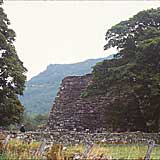
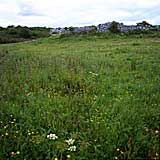
After the megalithic era of graves and the first farmers, the Celts came to the British Isles. Some of their dwellings can still clearly be seen - though the
remains are just a few feet or metres high now.
Especially in Ireland lot of ring forts
(500BC - 500 AD) can be seen. Their Celtic name is dun, which forms part of many present place names. These are stone enclosures, originally about a metre deep and more than a man's height. Most of these duns have a diameter of about 20 to 40 metres. Their purpose probably was to safeguard cattle and humans during raids and fights.
In the same period hundreds of brochs were built in Scotland: stone towers for living and defence up to 20 metres height and a 10 metres diameter. The walls were hollow and served as places of storage.
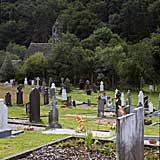 Though the Romans never conquered the Scottish Highlands or Ireland, these areas were
converted to Christianity at an early date. Churches, chapels and holy wells can be found everywhere - often in the most remote places. Some are more than 1400 years old!
Though the Romans never conquered the Scottish Highlands or Ireland, these areas were
converted to Christianity at an early date. Churches, chapels and holy wells can be found everywhere - often in the most remote places. Some are more than 1400 years old!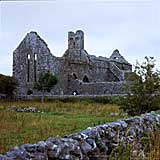 During the Middle Ages lot of abbeys were built, but nowadays nothing but ruins are left. The moment the English and Scottish kings embraced
Protestantism in the sixteenth century, most of the monasteries were closed down and the buildings outside the cities fell into decay.
During the Middle Ages lot of abbeys were built, but nowadays nothing but ruins are left. The moment the English and Scottish kings embraced
Protestantism in the sixteenth century, most of the monasteries were closed down and the buildings outside the cities fell into decay.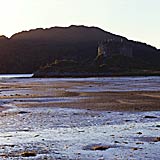
Numerous castles date from the same period. Simple towers and extensive structures can be found in many areas. After the wars against the English in the seventeenth and
eighteenth century lot of castles were dismantled or abandoned for more comfortable houses.
During the last century some castles have been rebuilt, often surrounded by beautiful gardens. Others are just a heap of stones, hardly to be seen in the landscape.
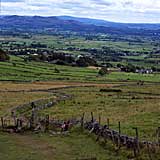
Because of social changes in the eighteenth century the relationship between local communities, the clans, and their chiefs changed and social distance grew. The latter acted more and more like landowners in stead of heads of their communities. They wanted their land to yield more. That caused a shift from small and mixed land use to larger fields and herds.
Enclosure Acts in particular left their traces in the landscape. In most parts of the British Isles the land was
parceled out in larger entities. The new fields and pastures were enclosed by the typical walls and hedges.
Around the year 1800 a new breed of sheep was bred, which could endure the harsh Highland winters. The price of wool was high at the time. Therefore it was attractive to have as many sheep as possible. The landowners had but one problem: the land was in use by their tenants. They lived in townships (like Auchindrain). Around the houses - about 10 in a township - they had their fields and vegetables, beyond which were the common grounds where the cattle grazed.
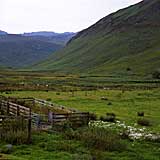
In order to achieve the breeding of sheep and higher yields they had to remove the tenants (their own loyal clansmen!) from their houses: the infamous clearances. If tenants didn't move willingly then their houses were burnt down and if needed the army was called to help with the removals. For property is holy according to law - and the tenants' houses are the landowners' property. If he wanted to burn down the houses - well, it was his right!
Many people emigrated to America or Australia. Others settled as best they could on the coast. As crofters they paid their rent from the yields of their crofts, small and rather infertile fields (the more fertile parts were used for the lucrative breeding of sheep), fishing and anything they could turn their hand to.
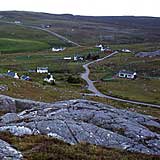
The splitting of the coastal area into crofts led to the typical pattern of settlement in the Highlands: scattered houses along the coastal roads. Here and there there are small harbours with lobster traps and small scale fishing - the evicted farmers weren't able to raise enough money for a large scale commercial fishing industry. Nowadays the income is often supplemented by tourism - as can be seen from the large number of craft shops and B&Bs.
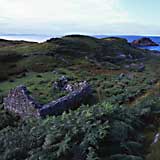
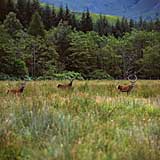
And what about the glens? Where once were numerous townships there is nowadays just a single sheep farm. The derelict tenant houses are overgrown by weeds. And when in the middle of the nineteenth century the demand of wool decreased dramatically, the sheep were discarded and the farms were changed into shooting estates:
vast areas used only for the hunt of deer or fowl. English and Lowland lords paid large sums to shoot these animals during their short stays. Outside the hunting season these animals were rigorously protected - and many birds of prey were poisoned to protect the grouse.
Even at this time the number of deer (and sheep!) is higher than nature can tolerate, the pressure of grazing is too high. The famous moors are actually wet desserts: ecologically they are severely impoverished. As soon though as the grazing is stopped, original vegetation recovers (as discussed here).
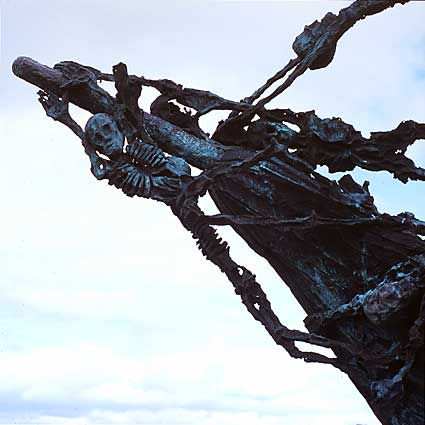
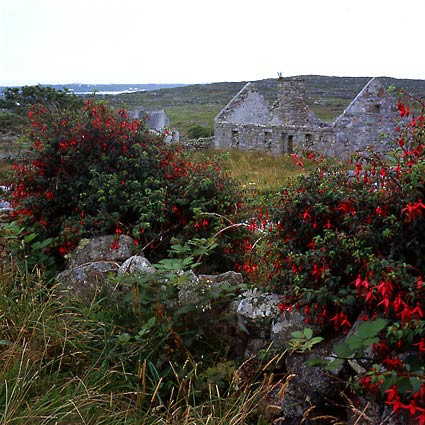
The same nineteenth century in Ireland saw an even larger drama. After the introduction of the
potato in the eighteenth century it soon was the most important food for the poor. The population grew quickly to eight million people around 1830. A number of terribly poor harvests in the 1840s, a totally failing government policy led to more than one million people dying of starvation - nevertheless at the same time cereals the poor couldn't afford to pay were exported to England as normal. Another million emigrated in miserable circumstances, in particular to the United States.
The rural parts of Ireland changed radically. A lot of villages were depopulated, large parts of the countryside were no longer cultivated. It took more than a century before migration to the urban areas and emigration stopped.
Unlike elsewhere in Europe both world wars didn't affect much of Ireland and Scotland - though many Irish and Scots soldiers were killed around the world. Apart from some newer buildings most villages still look the same as a century ago. The countryside escaped the ravages of large scale industry - although there is a considerable off shore oil industry in Scotland.
Nevertheless the countryside is changed. Roads are improved, water reservoirs and hydro-electric works are carried out.
Mechanization, fertilizer and European policies have changed agriculture radically and therefore the aspect of fields and pasture land. Other pieces of land had too low a return and were given back to nature.
The economic revival in the nineties, and European investments, made up for a very good infrastructure. Roads were widened and local
industry is supported. Especially in Ireland a wave of new buildings, new road lay-outs and small industry shows that the countryside is an attractive place of working and living again.
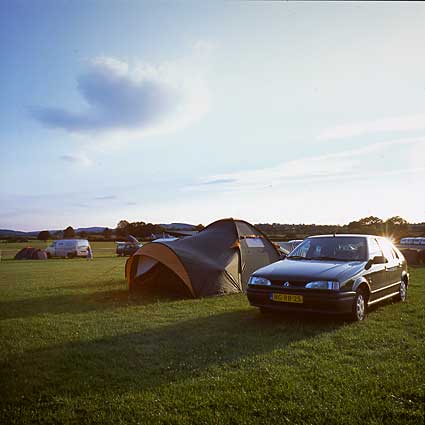
Tourism has become an important part of local economies - even if the large scale of the Spanish costas or Alpine ski resorts are avoided. Most tourists are attracted by the landscape, outdoor activities and come to avoid the crowds.
The most visible change to the landscape is the arrival of forestry. Large parts of the land are
transformed into rectangular 'tree-fields' with their typical monotony of such forests. After the felling of large plots an alien landscape of stumps and a few miserable small trees not worth the trouble of felling, are all that remains.
The last decades the forestry enterprises have tried to bring more of a variety of tree species and felling regimes. That way the forestry is less vulnerable to disease and storm damage. Because an
average growing and felling cycle is about 40 years it will take some time before the worst of the monotony is over.
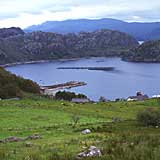
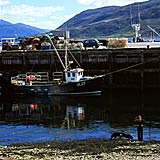
Due to the geography of Ireland and Scotland it is no surprise that their inhabitants always have added fish to their diet. After the Clearances people were driven to the coast and fishery became more important. Nowadays Scotland, and Ireland as well, have some of the largest European fishing ports - the amount of fish caught each year is even threatening the resources.
In many a sea loch fish farms
have been introduced in recent years. Pollution and the building of hydro-electric works made the number of fish in the rivers drop dramatically.
In large floating cages the fishes are now grown to the desired size. Apart from
employment - a scarce commodity in these remote parts of the country - fish
farming brings the debate: to what extent can mankind make use of the vulnerable marine environment?
During the last century agriculture became more and more a large scale activity. Most of the population live in urban areas. Exactly this century has seen people becoming aware of the importance of nature conservation and recovery. Vulnerable areas are often protected. Elsewhere there are attempts to reverse the damage done by overgrazing, unbalanced management and pollution.
Of course this is a wearisome process. Too often short term interests prevail over concern for the future. And the quest for a balance between
employment for the local population and space for nature lasts forever.
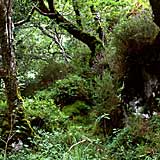
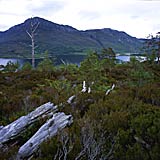
Good examples of durable nature conservation are the recovery of the original
oak woods on the Loch Sunart coast - a scheme initiated by the Forestry Commission, the official body for commercial forestry.
In the Ben Eighe area and around Loch Affric work is done to restore the old Caledonian Pine Woodland. Large fences keep grazing deer and sheep out of the area, enabling the forest to regain vitality.
It is to be hoped that nature is given a chance to have her own dynamics - if mankind realizes in time the need of adapting its ever changing life style to nature.
This article was written by Wim van Velzen, © 2002. I'd like to thank Struan Gray, John MacPherson and Keith Laban for their help!
Comments on the article and photographs are welcome!The landscape photographs shown here and lots more are put in several portfolios!
It is also possible to order landscape prints or to use them editorially or commercially.